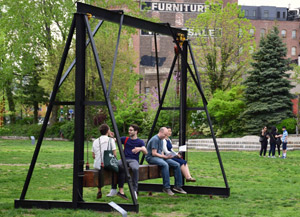1.31.25 — Psst, Pass It On
In stepping off the wall, can art trace the materials of a life? This year’s Studio Museum artists in residence make it so.
A bit premature, with most of their lives ahead of them? The program has a track record of singling out African American artists with a future. Still, late Modernism taught to see drawing in space and art as object, and now anything goes, anywhere between the ceiling and the floor. New York galleries step off the wall all the time, to give material shape to a career.  And I work this together with past report on Paula Wilson and Virginia Overton in Tribeca and Leonardo Drew in Chelsea as a longer review and my latest upload. It might be all about them or you—oh, sorry for missing my Wednesday morning post for once, but I was having an ankle repaired, and here I am hopping back to business.
And I work this together with past report on Paula Wilson and Virginia Overton in Tribeca and Leonardo Drew in Chelsea as a longer review and my latest upload. It might be all about them or you—oh, sorry for missing my Wednesday morning post for once, but I was having an ankle repaired, and here I am hopping back to business.
A program of artists in residence is a good deal all around. Artists in need of a break get a free studio, the imprimatur of a museum, and a show at year’s end. The rest of us get an insider’s view of an artist at work. Whatever are they doing in all that time, and what emerges day by day? That is not to say that I can handle another open-studio weekend, long past the heady days of Williamsburg, Bushwick, and Dumbo—and no one to screen the artists but those who attend. But this program belongs to the Studio Museum in Harlem, still closed for expansion and renovation, and the exhibition takes place one more time at MoMA PS1, as “Pass Carry Hold” through February 10.
It sounds modest enough from its title (psst, pass it on), and it looks modest enough, too. The three African American artists get adjacent quarters along the hall, rather than dividing one of the museum’s spacious wings like last year or the year before. It could well replicate the layout of their studios uptown, only smaller. Why the modesty? You might expect the three to spend the year amassing a body of work and a profile as an artist. Instead, each has nurtured a single work as it comes to be.
At least it seems so. Malcolm Peacock divides his space with a black curtain, like a theater, and his comedy or drama stars family and friends. Their indecipherable voices fill the air around just one object behind the curtain, in the shape of a giant redwood. A tree like that lives a long time, and who knows how much it might grow in the course of a year, but this emerging artist aims for stability. The trunk’s warm red comes from from hair on a wood frame that seems to twist as it grows, like the twist and turns of a human lifetime. Hairs have sharper colors as well, in highlights of his own devising.
Zoë Pulley starts with family, too, while reaching out. “What,” she asks, “is a memory you have with one clothing item from your childhood?” She assembles memories of her own and her parents’ childhoods, which is good, because I, for one, could not have come up with a single one. She fashions images of a blouse, a shirt, and a suit into plastic and vinyl, hanging beside a tapestry of seat belts. Apparently the past is more confining than she might wish. And maybe the truly clothes conscious start young.
If Pulley feels constrained, though, she never lets on, and the same items appear in photos of family members with ornate black frames. Their ovals suggest still older fashions, as do memorabilia like a telegram from Western Union. They are separate works, but connected: they recall a wrenching move from Washington to Prince George County—not far, but just far enough to her set her on the course of a life. If an emphasis on clothing translates into gender awareness, the third artist, sonia louise davis, sees her woven work as “feminist abstraction.” And she, too, treats it as almost an installation to itself.
These are “soft paintings,” in the present-day fashion for a woman’s craft as art and weaving as painting. They earn their softness at that, with varieties of wool in a loose, broad weave. She hangs some off the wall so that one can see both sides of a material object, contributing to the sense of an installation. So does a second room for sound art, a simple banging on metal from, she explains, impressions on her daily walks in St. Nicholas Park in Harlem. It rings out like bells beside wall painting that could be anything from living things to a Soviet hammer and sickle. Memories are deceptive and often sentimental, and so it is for all three, but so, too, is the passage from childhood to a career in art.
Read more, now in a feature-length article on this site.